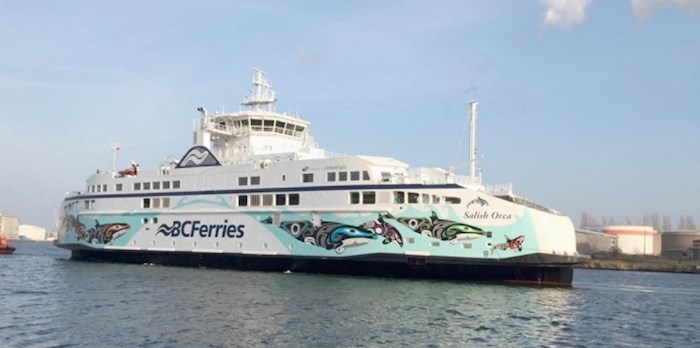BC Ferries says its ships carried a record number of vehicles in the first quarter of this year and passenger figures were the highest in two decades.
During the period April 1 to June 30 the total number of vehicles carried was up 2.64 per cent and the number of passengers was up 2.08 per cent compared to the same three months of 2017.
 The Salish Orca is one of three ships delivered last year from Poland in a $200-million project. Photograph By TIMES COLONIST
The Salish Orca is one of three ships delivered last year from Poland in a $200-million project. Photograph By TIMES COLONIST
Deborah Marshall of BC Ferries told Coast Reporter that numbers for Route 3, Langdale - Horseshoe Bay, remained fairly consistent with an increase of just 0.03 per cent in vehicle travel and 2.51 per cent in passengers carried.
The financial numbers show the increase in passengers didn't translate into an increase in net earnings. BC Ferries said net earnings for the first quarter of fiscal 2019 were $6 million, down from $17.3 million for the same quarter last fiscal year.
BC Ferries blames the decrease on having to contribute to the April 1 fare reductions as well as adding more sailings to try to keep up with the demand.
Free travel on Monday to Thursday sailings for B.C. residents age 65 and older was also reintroduced April 1.
According to the company’s release, “Revenues increased by 1.5 per cent to $229.7 million in the quarter primarily as a result of the increased traffic levels, partially offset by a decrease in the average tariff per passenger and per vehicle due to the fare reductions.”
President and CEO Mark Collins said, “With traffic levels the highest our company has ever experienced we continue to add service where possible, resulting in higher operating expenses.”
Those expenses increased by 7.8 per cent to $209.9 million, mainly as a result of the cost of 352 additional round trips and implementing schedule adjustments for the routes operating out of Horseshoe Bay.
The spike in ferry travel in the first quarter of the 2019 fiscal year follows a record-setting 2018 fiscal year.
The period from April 1, 2017 to March 31, 2018 saw a five per cent increase in vehicle traffic over the 2017 fiscal year, and a 4.7 per cent increase in passenger traffic.



